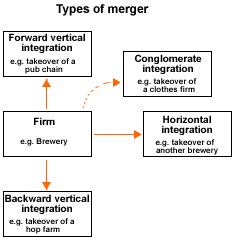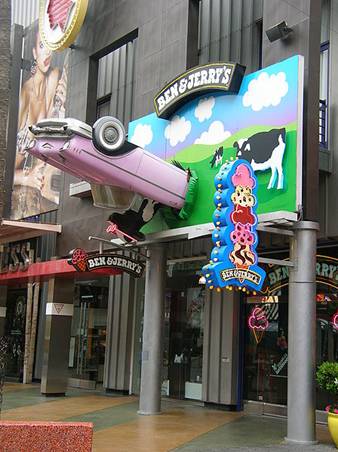Mergers and takeovers AO3 only
AO3 You need to be able to: Demonstrate synthesis and evaluation. Command
terms these terms require you to rearrange component ideas into a
new whole and make judgments based on evidence or a set of criteria. Compare,
Compare and contrast, Contrast, Discuss, Evaluate,
Examine, Justify, Recommend, To what extent
Buying a competitor, supplier or business customer can increase the speed of growth
We will now look at these in the context of an example firm - Student Computers plc. This company manufactures computers that it sells to retailers. It buys in most of its components.
How might it grow?
1. It could arrange a merger or a takeover.
Merger
Two firms agree to become one. They agree to merge. They become partners. This is unlikely to be the position for long as one partner starts to dominate. Staff will have to be made redundant, as two parallel staffs are not required. The new business starts to look for economies. At Board level, there is no room for two Chairmen, two Chief Executive Offices. Which of the directors leave the organisation will indicate which of the firms is dominant.
Takeover
A takeover is when one firm buys another, with or without its
approval. One firm is dominant and becomes the owner. It is the
taken-over firm that will face the brunt of the redundancies. For large
companies (PLCs) it is necessary only to buy a certain proportion of
the shares available on the Stock Market.
Takeovers and mergers could be horizontal or vertical.
Horizontal merger
A horizontal merger is when two companies in the same industry and at the same stage in the chain of production merge. An example is a merger between two breweries. It is also known as horizontal integration.
Vertical merger
A vertical merger (integration) is where firms at different stages of the production chain merge together. It may be either vertical forward integration where a firm merges with another further up the chain (e.g. a brewery taking over a chain of bars) or vertical backward integration where a firm merges with one further down the production chain (e.g. a brewery taking over a hop farm).
If a firm controls the whole distribution channel it is totally vertically integrated e.g. Shell owns oil-rigs, oil tankers and pipes, refineries and petrol stations.
Firstly, a reminder that firms can operate in one or more of the following sectors:
- Primary sector - extractive industries e.g. farming, mining, forestry and fishing.
- Secondary sector - manufacturing and construction.
- Tertiary sector - services (shops, banks etc.)
- Quaternary sector - high technology businesses
For a more detailed reminder of the various sectors, you may like to look at the 'Sectors of the economy' interaction in an earlier section.
Figure 1 below summarises these possible types of integration.

Figure 1 Different types of integration
2. It might aim to become a conglomerate.
This means that the firm, for example Student Computers plc, would expand into all sorts of activity - property management, mining, selling of CD's. The only requirement is that they can make money out of it.
Most conglomerates are also multinationals as they operate in more than one country.
3. In certain circumstances, there may be a management buy-out.
This is when the management of a firm, usually with the help of a venture capitalist, offer to buy the company. This rarely occurs when a firm is doing really well, more often when it is in trouble, or is facing a take-over from other companies.
4. They may buy a brand from another firm
The process of buying a brand from another firm is known as brand acquisition. It is not a full merger - that means the purchase of the whole company, but is simply the takeover of one of the firm's brands. Firms may often sell brands if they feel they do not tie in with their core business.
Risks and rewards
The opportunities from takeovers and mergers are obvious - Economies of Scale, increased market share, access to new markets, access to private R&D, less competition - but they can be obvious to the competition as well. A plc is always vulnerable to an unfriendly takeover. All that is required is for 50% of the shares of a business, plus one more, to be bought by the acquiring business. As quoted companies cannot restrict sales of their shares on the stock market, they have little defence to a predator, except to try to persuade existing shareholders not to sell their stake.
The rewards for the acquiring business can be summarised as:
- Economies of scale
- Faster growth
- New products
- Access to R&D
- New key personnel
- Access to new markets
- Greater market share
Firms looking for suitable merger partners or acquisitions often seek economies of scale and synergies. Synergies refer to a fit of complementary activities; rather like pieces of a jigsaw. A synergy is like saying '2 + 2 = 5, the whole is greater than the value of the two independent parts. This was a term first adopted in a business context by Igor Ansoff, who was responsible for establishing strategic planning as a management activity in its own right.
Examples and illustrations
This is an area where it may be useful to bring in examples (where relevant). A good way to find these is to do a search in the Biz/ed In the News archive. You might want to try searching on terms like:
- Merger
- Takeover
You can try this in the window below:
Often customers like to shop with small local or regional firms, especially if they are founded on certain socially responsible criteria or perhaps just quirkiness. They build their goodwill on this basis and their independence. However, as these businesses grow and become more profitable, they often become the target of takeover, and despite the owners best intentions it may be difficult for them to resist the substantial rewards from selling to a larger company.

Ben & Jerry's
 One example of a controversial takeover is Ben & Jerry's ice cream, acquired by the multinational Unilever. Ben & Jerry's was founded by "hippy capitalists" Ben Cohen and Jerry Greenfield in a converted petrol station in Vermont in 1978.
One example of a controversial takeover is Ben & Jerry's ice cream, acquired by the multinational Unilever. Ben & Jerry's was founded by "hippy capitalists" Ben Cohen and Jerry Greenfield in a converted petrol station in Vermont in 1978.
The founders always believed passionately in the social principles of their business and in the need to be environmentally friendly in their operations. In 1985, the Ben & Jerry's Foundation was established with a gift from Ben & Jerry's to establish community-oriented projects and then funded each year from a donation equivalent to 7.5% of the company's pre-tax profits. The firm's customers tended to support the high ideals of the business and were shocked when the founders decided to sell their business to a large corporation in 2000.
Unilever, the Wall's ice cream and Flora margarine group, strengthened its brand portfolio paying $326m for the ice-cream business. Ben & Jerry's unusually-named flavours, such as Chunky Monkey and Cherry Garcia were added to Unilever's Wall's ice-cream brands, including Magnum and Solero. Details of the takeover were reported on the BBC website:
However, Unilever took the strategic decision to keep Ben and Jerry's separate from the main Unilever business in an attempt to retain its reputation for corporate social responsibility (CSR) and the attached customer goodwill and brand loyalty. Many commentators saw this as a cynical, rather than a principled move. If you visit the Ben & Jerry's website there are no overt references to Unilever as the parent company. For instance, the chronological history of the company does not include the takeover.
The following article about the takeover identifies many of the issues that face small firms as they grow and change in nature and business structure:
Stop me and buy a Ben & Jerry's

Questions:
- Distinguish between a takeover and a merger
- Explain the importance of customer loyalty to Ben and Jerry's
- Analyse the advantages and disadvantages of the ethical objectives that underpin Ben and Jerry's operations
- Evaluate the reasons for Unilever's takeover of Ben and Jerry's
